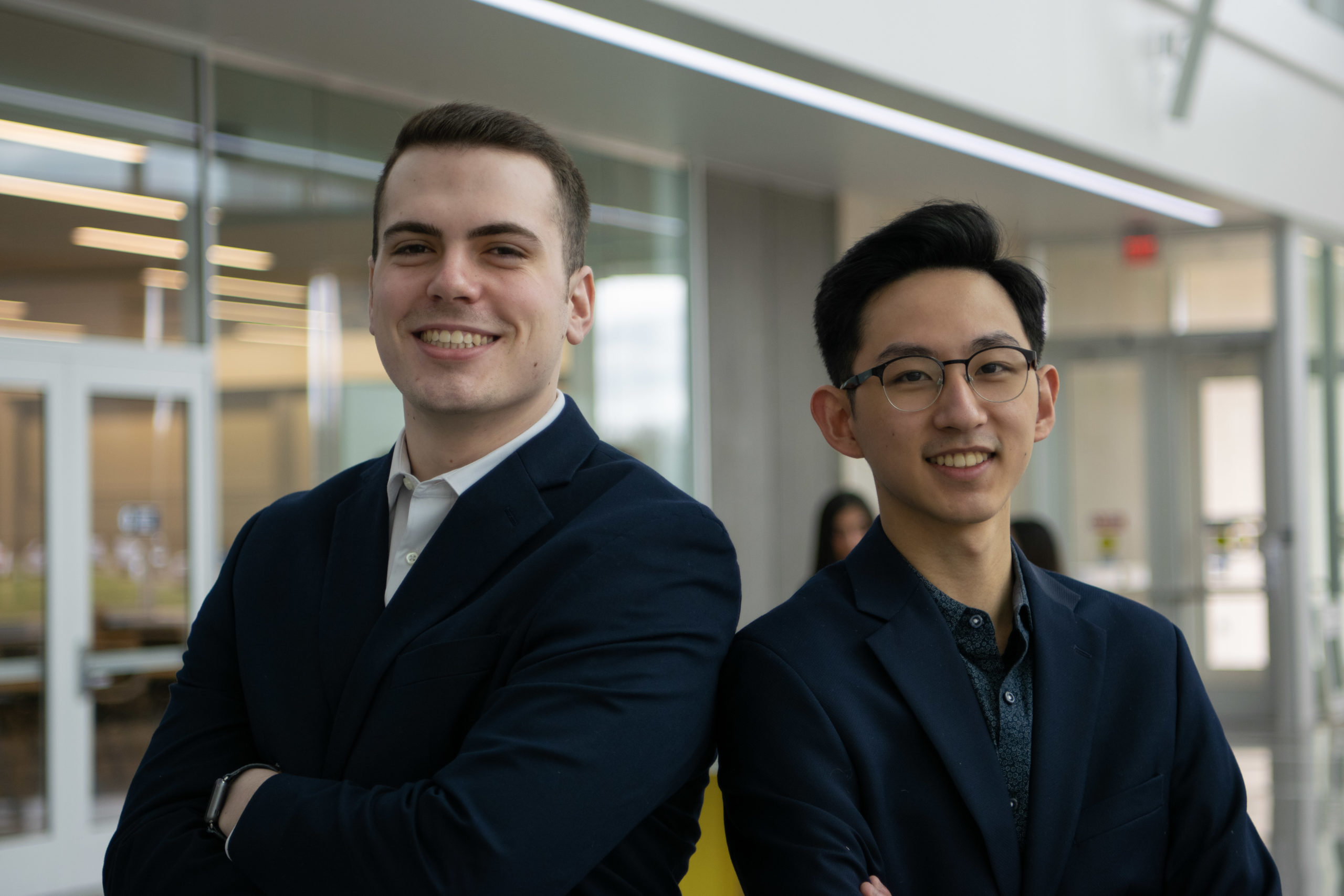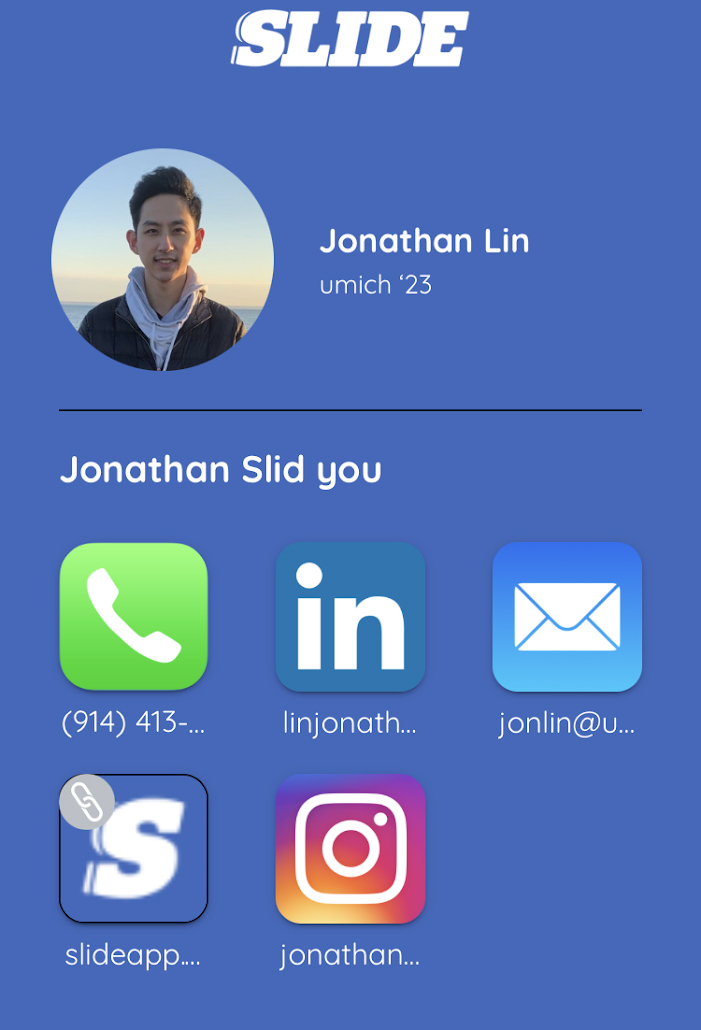With Slide, student entrepreneurs aim to make contact sharing frictionless
Built by students and funded by student VCs, the venture marks a new model for launching ideas into ventures.

 Enlarge
Enlarge
Sharing contact information is a common task and one that we do often. But it’s surprisingly inconvenient, and existing automated solutions don’t provide flexibility.
In February 2020, undergraduate students Matthew Lichtinger (computer engineering) and Jonathan Lin (computer science) recognized this problem and decided that there must be a solution for it.
“The biggest issue for us as students is that we were engaging with student organizations, visiting bars or parties, interviewing and joining companies for internships, and making lots of other new connections under differing circumstances,” says Lichtinger. “It is tough to quickly connect with people to exchange social media information and phone numbers, and to be able to only share the details that you want to share. It leads to sending texts back and forth or letting someone copy information off of your phone, which is not ideal.”
Lichtinger and Lin wanted to be able to instantly and contactlessly share information that fits the meeting context easily, and at once. “We’ve seen some people try to address the business card exchange problem, but not with the flexibility to share different information in different situations. Because in a social situation you might want to share your phone number, Snapchat, and Instagram, but in a business situation you might share email, Facebook, and LinkedIn pages,” Lichtinger says.
In response to this need, the two conceived of Slide: an app that would allow for the easy creation of contact profiles, coupled with a quick and simple way to select and contactlessly share profiles.
There were barriers to making this app a reality. The first, according to Lin: “At the time we first imagined Slide, neither of us had significant web or app development experience, and we had not yet held technical internships.” Over the summer of 2020, the two started learning the technical details of creating the app. Covid was a factor, so they worked remotely, but the pandemic also gave them more time to study. They learned a lot, but had made only a rough start on the app itself by the end of summer.
“The big breakthrough came over Thanksgiving break,” continues Lin. “I went to Matt’s house and we coded nonstop for days to build out the app.” They built Slide using the development framework Flutter, which provides cross-platform support and allowed them to simultaneously develop iOS and Android versions of Slide.
As Lichtinger and Lin developed and refined Slide in the Fall of 2020, they made important connections to resources at the University which allowed them to improve the product and get Slide off the ground.
Two resources were primary. One was the College of Engineering’s Center for Entrepreneurship, which helped the duo to develop their pitch and pointed them to additional resources including the law clinic, a marketing group, and a user design group.
In addition, they connected with UpRound Ventures, a student-run venture capital fund at the University. “We went to a student venture showcase where a bunch of startups could come and pitch,” Lichtinger said. “About two weeks after we did that, UpRound reached out to us.”
Slide emerged as UpRound’s first investment, according to Kelly Kwan, an industrial and operations engineering student and VP of Fund at UpRound. “Slide was chosen as the organization’s first investment after many months of due diligence.,” said Kwan. “We really liked Matt and Jon as founders – they were both technical and scrappy. A strong founding team can go a long way. There was also a large market opportunity for the product, and we liked how the app had 430 users and was growing.”
UpRound was founded in 2017 to build new connections for the startups in southeast Michigan and to give undergrads a look into the world of venture capital along the way. Along the way, the group has built connections with VCs and firms around the country. Their current focus is to help launch startups founded by current U-M students and alumni.
“We started raising our fund in fall 2020, and our goal is to help Michigan-affiliated startups to grow their ventures,” Kwan said. “We’re really excited that our first investment was with Slide.” The College of Engineering has been the fund’s largest contributor.
According to Lichtinger and Lin, the UpRound funding will be used to further market the product and for other business costs.
In terms of marketing, the plan is to launch from the university out. That means that their initial focus will be on university and student events and communities. It’s a landscape that the developers are familiar with and one that scales well with their growth plans and resources. Beyond that, the team sees opportunities at trade shows, conferences, and at corporations.
With the help of the UpRound Accelerator, the team hopes to incorporate an envisioned group feature, in which people can form and join social or work groups with their Slide profiles.
“Without Michigan and the resources here,” said Lichtinger, “I don’t know where we would be and we may not have gotten this far. We are eternally in debt to the College of Engineering, the Center for Entrepreneurship, the students, the Law Clinic, the UX Design Clinic, and so many other resources that we have used for free. It has been immensely helpful for us.”
“There’s a ton of resources that just don’t exist at other places,” adds Lin. “I don’t think we’d have been able to bring our idea to market without the help and support of the University programs, including UpRound.”
How does Slide work?
Slide is the quickest way to share your phone number and social media with others.
Slide allows you to create up to ten profiles containing any combination of your socials, email addresses, and your phone number, allowing you to be prepared for any situation, whether that be a “social” profile for a night out, a “business” profile for sales meetings and conferences, or simply “phone” and “Snapchat” profiles for sharing just one username at a time.

 Enlarge
Enlarge
When sharing contact information with someone who also has the Slide app installed, Slide makes it easy to connect and share. First, Slide users are notified about other nearby users by the app. Then it’s a simple matter to select a Slide profile and “slide” that profile to a recipient. Once a profile is received, the recipient can choose to tap on an icon (phone, Instagram, etc.) in the received profile to add that number to their contact list or to follow that social media account.
Slide also allows for easy sharing with a person who does not have the Slide app. In this case, Slide provides a QR code right in the app that contains a personal link you can share with others to bring them to a web version of your profile, just as if they were receiving it in the app. You can even display this QR code and/or your personal Slide link anywhere you want to share your information more broadly.
And while Slide currently solves the problem of sharing contact information and social media directly with others, the company is currently developing the capability for Slide Groups, which will allow you to create groups for an organization that people can Slide into. For example, think of an “active members” group, a “new members/applicants” group, an “alumni” group, and so on. This will eliminate the need to maintain member directories, alumni databases, or worry about getting new member information. Everything will be streamlined in your org’s Slide Groups, and your members will be better connected than ever.
 MENU
MENU 
